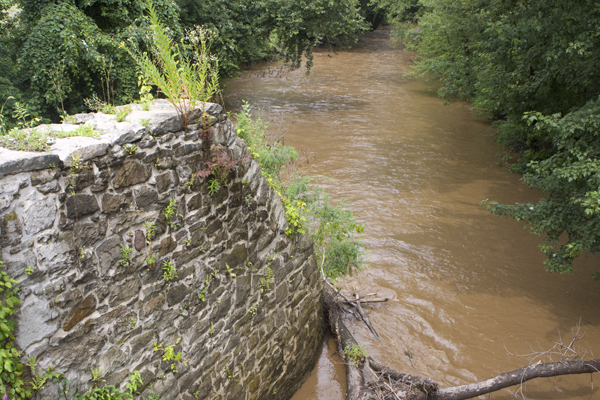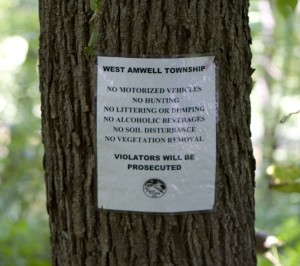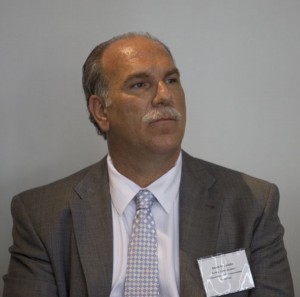The Wind Does Not Justify The Means
DEP Commissioner Complains About Political Pressure from the “Front Office”

Raritan Bay estuary, site of proposed wind project behind Bayshore Regional Sewer Authority Plant
[Update: 10/25/09 – Star Ledger – Proposed New DEP Regulations Renew Sniping Among Environmentalists
I support wind power, but will not sit idly by and watch as wind lobbyists dictate DEP policy and permit decisions.
And we are not fooled by cynical PR stunts by the Governor to create a false appearance of reform – see Corzine Executive Oder #148.
We have been writing a lot about undue and improper political pressure on DEP (for example, see: Political Pressure on DEP – How The Game is Played where we disclosed exactly how former DEP Commissioner Brad Campbell and State Senator Sweeney (D-Gloucester) are strong arming DEP to issue wind approvals in Delaware Bay).
But the politics have gotten so bad that now even the DEP Commissioner is complaining about it (see this for DEP emails linking wind lobbyists, the Governor’s Office, and DEP Commissioner).
Some of this improper pressure recently resulted in criminal indictments of State Assemblymen Van Pelt (R-Ocean) and Smith (D-Hudson) (See: DEP Involved in Corruption Scandal).
Assemblyman Van Pelt was indicted for taking a bribe to use his legislative powers to pressure DEP to issue CAFRA permits. He bragged that DEP “worked for him”, that he knew how “to work the channels” at DEP, and that he had sucessfully pressured DEP to issue prior CAFRA and wetlands permits. (see Van Pelt criminal complaint here).
On its face, the Van Pelt’s indictment creates an appearance of impropriety in terms of political influence on the DEP permit process. This requires investigation to get the facts surrounding Van Pelt’s influence on DEP, if ONLY to vindicate DEP and restore public confidence in DEP (see Star Ledger: N.J. environmental groups call for investigation of DEP in light of corruption arrests).
Governor Corzine’s own EO 148 admits the problem, but Corzine cynically diverts attention to local officials (instead of State officials) and limits solutions to the local level in only a handful of towns:
WHEREAS, because of the nature of the reported conduct on the part of these local officials charged with corruption, and particularly those who choose to remain in office, and in furtherance of this administration’s commitment to ensuring the integrity of all State approval processes, it is appropriate to provide for additional scrutiny of applications for State approvals that involve jurisdictions headed by officials charged in the corruption probe who remain in office; (link to EO 148)
Assemblyman Smith was indicted for taking a bribe and promising to get DEP approval of a toxic site cleanup (NFA letter) in Jersey City in order to build a daycare center and public housing. The Smith criminal complaint has a wired cooperating witness (CW) saying that Smith called DEP Commissioner Mauriello. The CW’s wire then says someone from DEP called Smith back and that- after the callback from DEP – that everything is OK in securing DEP approvals.
The Bergen Record reported on leaked DEP emails that show at least 7 DEP staffers were involved in responding to Smith’s request, so clearly Smith was able to get the DEP’s immediate attention (see Bergen Record: DEP e-mails follow lawmaker’s request). And the criminal complaint also reveals a senior DOT official saying that the DOT approvals for the project was a good “business opportunity” for a colleague in DOT overseeing the approval. (see Smith criminal complaint here)
But there have been a series of other highly visible cases where the political pressure on DEP may not have risen to criminal conduct, but nonetheless were clearly unethical and harmful of human health and the environment. Many of these embarrassing episodes have gotten significant media coverage, such that DEP’s integrity is reasonably subject to question by a skeptical public.
The latest episode in the saga of politicization of DEP decisions involves a wind project at the BayShore Regional Sewer Authority. The Asbury Park Press wrote about it Saturday (see: State: Wind turbine plan must satisfy DEP rules ) but that coverage got it wrong – we do NOT oppose this wind project – and the APP story really missed the most significant aspect of the story that we leaked to them.
In a September 23, 2009 e-mail to Kenny Esser from Governor Jon Corzine’s office, Fred DeSanti, a consultant for the project, asked for “direct intervention at this time from the front office” to stop the state Department of Environmental Protection from imposing “unreasonable and inflexible requirements” that would delay the project and possibly jeopardize the more than $3 million in federal stimulus funds.
DEP Assistant Commisioner Nancy Wittenberg – no tree hugger and a former NJ Builders Association lobbyist – sent an email to DEP Commissioner Mauriello that complained about Esser leaning on her. DEP Commissioner Mauriello echoed her frustration.
The next day, on September 24th, Mauriello sent an e-mail to his top staff complaining about being leaned on by the Governor’s office:
[The attached] “illustrates the pressure that Nancy [sic] is under related to this project, and we have little ability to control it and of course the full story and context does not get represented with these folks, but what else is new.”
So what else is new? Right.
Mauriello’s reply illustrates how bad morale at DEP has become due to constant political dictates from lobbyists and the Governor’s office to compromise environmental protections, suppress or distort science, and relax enforcement in order to promote economic development.
This has got to stop – DEP independence and integrity must be restored.
Despite the fact that wind power is a laudable and much needed renewable source of energy, the ends do not justify the means. Promotion of wind must not be allowed to compromise the integrity of DEP or protections of natural resources.
To begin to restore DEP integrity and public confidence in the agency, we need and independent investigation to document the causes and extent of the problem. Based on that investigation, a series of corrective action reform measures must be put in place.
One element of that reform effort must be transparency and disclosure requirements about exactly who DEP is meeting with behind closed doors. Sunshine is the best disinfectant and can counteract the power of special interests by empowering citizen watchdogs and news media (see: This Is Why We Need Transparency at DEP).
Another necessary reform measure is whistleblower protections. DEP staffers witness corrupt practices on a daily basis, but rightfully don’t want to sacrifice their careers disclosing wrongdoing. We need to empower the agency professionals and block the current widespread practice of retaliation for conscientious public disclosures of mismanagement, manipulation of science, and threats to public health and the environment.
NJ’s current whistleblower laws do not protect employees who disclose such problems publicly. (see: Star Ledger: End Political Influence on DEP regulators).
Another reform must include restrictions on what are legally known as “ex parte” communications to DEP. An ex parte communication is a communication to DEP from any person about a pending DEP matter that occurs in the absence of other parties to the matter and without public notice and opportunity for all parties to participate in the communication. People often refer to these communications as “one-sided,off-the-record,” or private communications between a DEP staffer and any person concerning a matter that is pending or impending before the DEP. According to California regulations:
Rules regarding ex parte communications have their roots in constitutional principles of due process and fundamental fairness. With public agencies, ex parte communications rules also serve an important function in providing transparency. Ex parte communications may contribute to public cynicism that decisions are based more on special access and influence than on the facts, the laws, and the exercise of discretion to promote the public interest.
Ex parte communications are fundamentally offensive in adjudicative proceedings because they involve an opportunity by one party to influence the decision maker outside the presence of opposing parties, thus violating due process requirements. Such communications are not subject to rebuttal or comment by other parties. Ex parte communications can frustrate a lengthy and painstaking adjudicative process because certain decisive facts and arguments would not be reflected in the record or in the decisions. Finally, ex parte contacts may frustrate judicial review since the record would be missing such communications.

Atlantic County Utilities Authority wind project – Atlantic City, NJ

